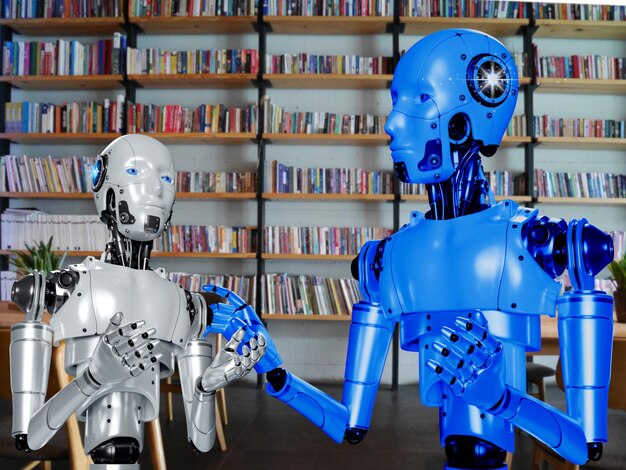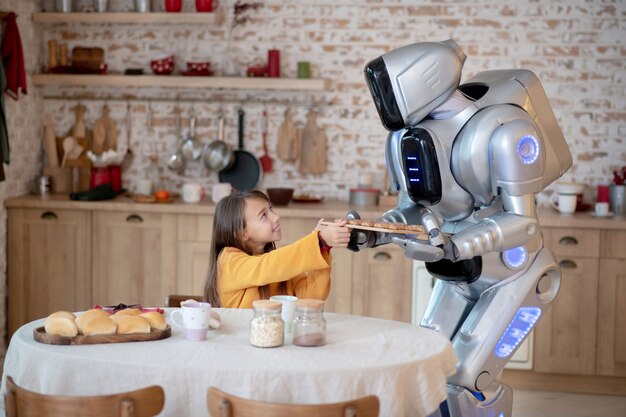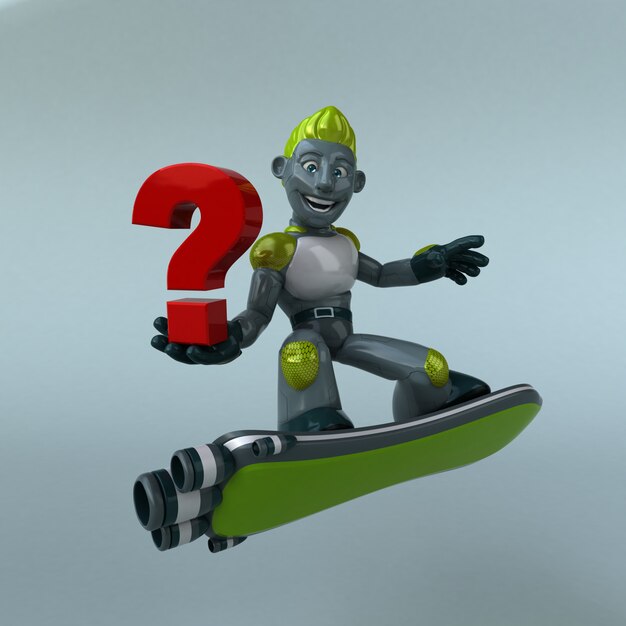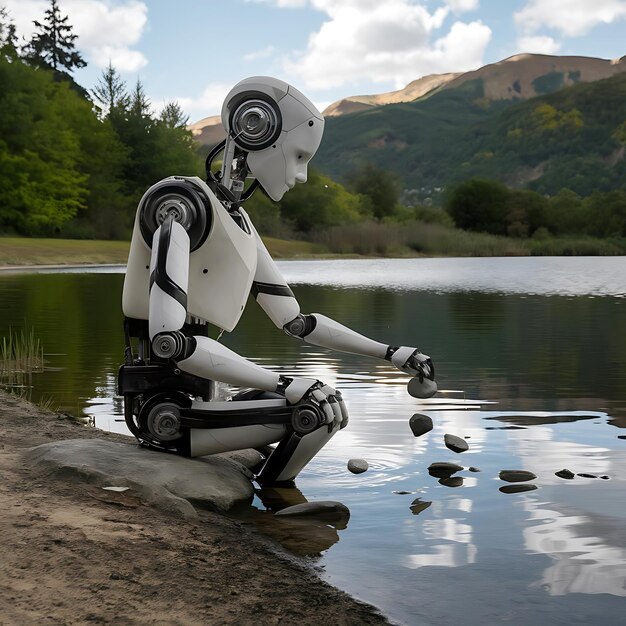The Future of AI Robots: A Glimpse into the World of Autonomous Machines
In the not-so-distant future, Artificial Intelligence (AI) robots are set to revolutionize various industries and aspects of our daily lives. These autonomous machines, capable of learning, reasoning, and adapting to new environments, are poised to bring about a paradigm shift in the way we live, work, and interact.
Revolutionizing Industries
The impact of AI robots is already being felt across industries such as manufacturing, healthcare, education, transportation, and finance. In manufacturing, for instance, AI robots are used for repetitive tasks, freeing up human workers to focus on more complex and creative roles. In healthcare, AI-powered diagnostic tools and robotic surgical systems are enhancing patient care and improving outcomes. In education, AI is being used to personalize learning experiences, enabling students to progress at their own pace.
Enhancing Everyday Life
Beyond industries, AI robots are also transforming everyday life. In homes, AI-enabled devices such as voice assistants and home automation systems are making living more convenient and comfortable. In transportation, self-driving cars and drones are set to redefine mobility and delivery services. In entertainment, AI-generated content is revolutionizing music, art, and literature.
Ethical and Social Considerations
However, as with any technology, the rise of AI robots also raises ethical and social considerations. Issues such as privacy, security, employment, and bias need to be addressed to ensure that the benefits of AI robots are realized without causing harm or exacerbating existing inequalities.
The Role of Governments and Regulators
Governments and regulators play a crucial role in shaping the future of AI robots. Through policy frameworks, guidelines, and standards, they can ensure that AI robots are developed and deployed responsibly and ethically. They can also facilitate collaboration between various stakeholders to address the challenges and opportunities presented by AI robots.
Collaborating for a Sustainable Future
In conclusion, the future of AI robots is an exciting and complex landscape that holds immense potential. By collaborating and working together, we can harness the power of AI robots to create a sustainable future where technology enhances human capabilities and contributes to the betterment of society as a whole.

Paragraph About Artificial Intelligence (AI) and Robotics
Artificial Intelligence (AI), a branch of computer science that aims to create intelligent machines, and Robotics, the technology dealing with the design, construction, operation, and use of robots, have been transforming industries and our daily lives in unprecedented ways.
Definition and History
AI is the development of computer systems able to perform tasks that normally require human intelligence, such as visual perception, speech recognition, decision-making, and language translation. Robotics, on the other hand, is the application of engineering principles to design, build, program, and control robots that can perform tasks autonomously or with human intervention. The history of AI and robotics dates back to the mid-20th century, with milestones such as Alan Turing’s concept of a “Universal Machine” in 1950 and Masahiro Mori’s development of the first robotic humanoid, GEORGE, in 1970.
Current State and Applications
The current state of AI and robotics is characterized by rapid advances, with applications ranging from self-driving cars and virtual personal assistants to surgical robots and factory automation systems. These technologies have led to significant improvements in productivity, accuracy, and safety while reducing human labor requirements.
Importance and Significance
The importance and significance of AI robots in today’s world can be seen through their numerous economic, social, and industrial impacts. Economically, they contribute to increased efficiency, reduced costs, and improved competitiveness for businesses. Socially, AI robots can perform tasks in dangerous environments or provide assistance for individuals with disabilities. Industrially, they help automate repetitive and mundane tasks, allowing humans to focus on more complex problem-solving activities.
Preview of the Future
Looking ahead, the future of AI and robotics promises even more exciting advancements. The development of autonomous machines, capable of learning, adapting, and operating on their own, has the potential to revolutionize industries and create new opportunities. With continued research and advancements, we can expect AI robots to become an integral part of our society, transforming the way we live, work, and interact.

Understanding AI Robots
Types and capabilities of AI robots
AI robots are advanced machines designed to mimic human intelligence and perform tasks that usually require human intervention. Reactive Machines, the simplest type, react to their environment based on programmed responses without considering past experiences or context. Limited Memory Machines can retain some information about the past for a short period to make better decisions.
Theory of Mind Machines
, also known as socially intelligent robots, can understand and respond to human emotions and intentions. Self-Aware Machines (theoretical) can have consciousness and self-awareness, which is the ultimate goal of AI development.
AI algorithms and techniques
AI robots use various algorithms and techniques for processing information, learning from data, and interacting with the environment.
Machine Learning (ML)
is a method of data-driven AI that enables machines to learn from experience without being explicitly programmed.
Deep Learning (DL)
is a subset of ML, which focuses on neural networks with multiple hidden layers to learn and represent hierarchical structures. Neural Networks are computational models inspired by the human brain that can recognize patterns from data.
Natural Language Processing (NLP)
allows machines to understand, interpret, and generate human language.
AI robot sensors and actuators
AI robots require sensors and actuators to perceive their environment, interact with objects, and communicate with humans.
Vision systems
enable robots to see and recognize visual information using cameras and computer vision algorithms.
Speech recognition
allows machines to understand human language, enabling communication with humans. Touch and force sensing help robots to sense physical contact and manipulate objects.
Navigation systems
enable robots to move around autonomously using various sensors such as LIDAR, sonar, or GPS.
Manipulation capabilities
enable robots to interact with their environment by grasping and moving objects using mechanical arms or hands.

I Future Applications of AI Robots
Domestic robots:
- Home assistance and automation: AI robots will manage household chores, from vacuuming and mopping to cooking and cleaning, providing convenience and efficiency for families.
- Childcare and elder care: Robots will assist in childcare with educational games, and provide companionship and care for the elderly, ensuring their safety and well-being.
- Entertainment and companionship: Robots will entertain us with music, art, storytelling, and games, providing companionship and reducing feelings of loneliness.
Industrial robots:
- Manufacturing and production: Robots will automate repetitive tasks, improve product quality, and increase productivity in manufacturing industries.
- Warehousing and logistics: Robots will manage inventory, sorting, and transportation in warehouses, reducing labor costs and increasing efficiency.
- Transportation and delivery: Autonomous vehicles and drones will deliver goods, reducing transportation costs and improving delivery times.
Healthcare robots:
- Telemedicine and remote patient monitoring: Robots will monitor patients’ health remotely, reducing hospital visits and improving patient outcomes.
- Rehabilitation and therapy: Robots will provide physical therapy and rehabilitation, assisting patients in recovering from injuries or illnesses.
- Surgery and diagnostics: Robots will perform surgeries and diagnose diseases with greater accuracy and precision than humans.
Service robots:
- Education and training: Robots will provide personalized education and training, adapting to students’ learning styles and improving educational outcomes.
- Emergency services: Robots will respond to emergencies, providing assistance in situations where human intervention is not possible.
- Security and surveillance: Robots will provide security and surveillance, detecting intruders and monitoring public spaces for safety.
E. Agricultural robots:
- Farming and agriculture automation: Robots will manage farmlands, monitor crop health, and perform tasks such as planting and harvesting.
- Livestock management: Robots will monitor livestock health, automate feeding and watering, and provide care to animals.
F. Space exploration robots:
- Mars rovers and other planetary missions: Robots will explore other planets, moons, and asteroids, providing valuable data and insights.
- Satellites and space station automation: Robots will manage satellites and space stations, performing maintenance tasks and collecting data.
- Deep space exploration: Robots will explore deep space, detecting black holes, neutron stars, and other celestial bodies.
G. Military robots:
- Unmanned aerial vehicles (UAVs): Robots will provide reconnaissance and surveillance in military operations, reducing risks to human lives.
- Ground robots for reconnaissance and bomb disposal: Robots will perform dangerous tasks, such as identifying landmines and bombs, reducing risks to human lives.
- Autonomous weapons systems: Robots will engage in military combat, reducing risks to human soldiers and improving efficiency.
H. Ethical, social, and environmental implications:
- Privacy concerns: The use of robots raises privacy concerns, as they may collect and share personal information.
- Employment displacement: The use of robots may displace human workers, leading to unemployment and economic challenges.
- Human-robot interaction and relationships: The use of robots may change human interactions and relationships, raising ethical concerns.
- Energy consumption and resource depletion: The use of robots may increase energy consumption and resource depletion, leading to environmental challenges.
- Environmental impact and sustainability: The use of robots may have a positive or negative impact on the environment, depending on how they are designed and used.
- Ethical dilemmas and moral considerations: As AI robots become more advanced, they raise complex ethical questions related to their behavior and decision-making capabilities. For instance, who is responsible for an AI’s actions if it causes harm? How should we program robots to make moral judgments and act ethically in various situations?
- Power consumption and battery life: AI robots require significant energy to operate, especially those with advanced AI algorithms and sensors. This can limit their mobility and ability to function for extended periods without recharging.
- Scalability and complexity of AI algorithms: Developing increasingly sophisticated AI algorithms requires vast amounts of data, computational power, and energy. Scaling up these systems to accommodate larger datasets and more complex problems remains a significant challenge.
- Legal frameworks and regulations: AI robots raise numerous legal questions related to liability, privacy, intellectual property rights, and safety standards. Developing appropriate regulatory frameworks will be essential to ensuring the responsible deployment of AI robots in various industries.
- Public perception and acceptance: Public concern and skepticism regarding AI robots are common, particularly when it comes to their potential impact on employment, privacy, and security. Addressing these concerns will be crucial for promoting widespread acceptance of AI robots in society.
- Collaborative development between humans, AI robots, and governments: Collaborating on the development of AI robots with input from various stakeholders, including governments, industry experts, ethicists, and the public, can help address technical and societal challenges.
- Continuous research, education, and training of professionals in the field: Ensuring that researchers, engineers, and policymakers remain up-to-date on the latest AI robot advancements is critical for addressing both technical challenges and public concerns.
- Open communication and transparency regarding AI robot development and implementation: Providing clear and honest information about AI robot capabilities, limitations, and potential risks can help build trust and alleviate public concern.

IV. Challenges and Limitations of AI Robots:
Technical Challenges
Societal Challenges
Strategies for Addressing These Challenges

Conclusion: The Future of AI Robots
As we have explored in the previous sections, AI robots have come a long way from their early beginnings. With advances in technology such as machine learning, deep learning, and natural language processing, these machines are now capable of performing tasks that were once thought to require human intelligence.
Advances in Technology
Looking forward, the potential applications of AI robots are vast and varied. From manufacturing to healthcare to education, these machines have the ability to revolutionize entire industries.
Future Applications and Their Implications
Future applications of AI robots, however, also raise important ethical questions. How will these machines impact employment? What are the privacy concerns surrounding their use of personal data? And perhaps most significantly, how can we ensure that AI robots are developed and used in a way that benefits humanity as a whole?
Societal Responsibility
It is essential that we continue to invest in research, innovation, and collaboration in the field of AI robots. By doing so, we can address these challenges head-on and ensure that the future of AI robots is one that aligns with our ethical values.
Encouragement for Continued Research, Innovation, and Collaboration
We must also reflect on our societal responsibility to guide the development of AI robots in a positive direction. This means engaging in thoughtful and inclusive conversations about the potential implications of these technologies, as well as investing in education and training programs to help workers adapt to the changing job market.
